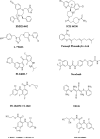Targeting the MAPK pathway in melanoma: why some approaches succeed and other fail
- PMID: 20450891
- PMCID: PMC2897908
- DOI: 10.1016/j.bcp.2010.04.029
Targeting the MAPK pathway in melanoma: why some approaches succeed and other fail
Abstract
The Mitogen Activated Protein Kinase (MAPK) pathway plays a key role in melanoma development making it an important therapeutic target. In normal cells, the tightly regulated pathway relays extracellular signals from cell membrane to nucleus via a cascade of phosphorylation events. In melanomas, dysregulation of the MAPK pathway occurs frequently due to activating mutations in the B-RAF and RAS genes or other genetic or epigenetic modifications, leading to increased signaling activity promoting cell proliferation, invasion, metastasis, migration, survival and angiogenesis. However, identification of ideal pathway member to therapeutically target for maximal clinical benefit to melanoma patients remains a challenge. This review provides an overview of the obstacles faced targeting the MAPK pathway and why certain therapeutic approaches succeed while others fail. The review summarizes the roles played by the proteins, therapeutic potential and the drugs available to target each member of the pathway as well as concerns related to each. Potential for targeting multiple points and inhibiting other pathways along with MAPK inhibition for optimal efficacy are discussed along with explanations for development of drug resistance, which includes discussions related to cross-talk between pathways, RAF kinase isoform switching and phosphatase deregulation. Finally, the use of nanotechnology is reviewed as an approach to target the MAPK pathway using both genetic and pharmacological agents simultaneously targeting multiple points in the pathway or in combination with other cascades.
Copyright 2010 Elsevier Inc. All rights reserved.
Figures




Similar articles
-
Current and future trials of targeted therapies in cutaneous melanoma.Adv Exp Med Biol. 2013;779:223-55. doi: 10.1007/978-1-4614-6176-0_10. Adv Exp Med Biol. 2013. PMID: 23288642 Free PMC article. Review.
-
Mitogen-activated protein kinase dependency in BRAF/RAS wild-type melanoma: A rationale for combination inhibitors.Pigment Cell Melanoma Res. 2020 Mar;33(2):345-357. doi: 10.1111/pcmr.12824. Epub 2019 Sep 25. Pigment Cell Melanoma Res. 2020. PMID: 31518489
-
Antitumor activity of the selective pan-RAF inhibitor TAK-632 in BRAF inhibitor-resistant melanoma.Cancer Res. 2013 Dec 1;73(23):7043-55. doi: 10.1158/0008-5472.CAN-13-1825. Epub 2013 Oct 11. Cancer Res. 2013. PMID: 24121489
-
Melanomas acquire resistance to B-RAF(V600E) inhibition by RTK or N-RAS upregulation.Nature. 2010 Dec 16;468(7326):973-7. doi: 10.1038/nature09626. Epub 2010 Nov 24. Nature. 2010. PMID: 21107323 Free PMC article.
-
The rise of T-type channels in melanoma progression and chemotherapeutic resistance.Biochim Biophys Acta Rev Cancer. 2020 Apr;1873(2):188364. doi: 10.1016/j.bbcan.2020.188364. Epub 2020 Apr 7. Biochim Biophys Acta Rev Cancer. 2020. PMID: 32275934 Review.
Cited by
-
Malignant melanoma: evolving practice management in an era of increasingly effective systemic therapies.Curr Probl Surg. 2022 Jan;59(1):101030. doi: 10.1016/j.cpsurg.2021.101030. Epub 2021 Jul 7. Curr Probl Surg. 2022. PMID: 35033317 Free PMC article. Review. No abstract available.
-
Mycobacterium indicus pranii (Mw) inhibits invasion by reducing matrix metalloproteinase (MMP-9) via AKT/ERK-1/2 and PKCα signaling: A potential candidate in melanoma cancer therapy.Cancer Biol Ther. 2017 Nov 2;18(11):850-862. doi: 10.1080/15384047.2015.1078024. Epub 2015 Sep 21. Cancer Biol Ther. 2017. PMID: 26390181 Free PMC article.
-
Endolysosomal Cation Channels and MITF in Melanocytes and Melanoma.Biomolecules. 2021 Jul 13;11(7):1021. doi: 10.3390/biom11071021. Biomolecules. 2021. PMID: 34356645 Free PMC article. Review.
-
Anti-Melanogenic Effects of Ethanol Extracts of the Leaves and Roots of Patrinia villosa (Thunb.) Juss through Their Inhibition of CREB and Induction of ERK and Autophagy.Molecules. 2020 Nov 17;25(22):5375. doi: 10.3390/molecules25225375. Molecules. 2020. PMID: 33212959 Free PMC article.
-
A Unique High-Throughput Assay to Identify Novel Small Molecule Inhibitors of Chemotaxis and Migration.Curr Protoc Cell Biol. 2017 Mar 3;74:12.11.1-12.11.13. doi: 10.1002/cpcb.17. Curr Protoc Cell Biol. 2017. PMID: 28256720 Free PMC article.
References
-
- Shoo BA, Kashani-Sabet M. Melanoma arising in African-, Asian-, Latino- and Native-American populations. Semin Cutan Med Surg. 2009;28:96–102. - PubMed
-
- Jemal A, Devesa SS, Hartge P, Tucker MA. Recent trends in cutaneous melanoma incidence among whites in the United States. J Natl Cancer Inst. 2001;93:678–83. - PubMed
-
- Boni R, Schuster C, Nehrhoff B, Burg G. Epidemiology of skin cancer. Neuro Endocrinol Lett. 2002;23(Suppl 2):48–51. - PubMed
-
- Jemal A, Siegel R, Ward E, Hao Y, Xu J, Thun MJ. Cancer statistics, 2009. CA Cancer J Clin. 2009;59:225–49. - PubMed
-
- Cheung M, Miller C, Robertson GP. BRaf and malignant melanoma. Recent research developments in cancer. 2004;6:1–19.
Publication types
MeSH terms
Substances
Grants and funding
LinkOut - more resources
Full Text Sources
Other Literature Sources
Medical
Research Materials
Miscellaneous

